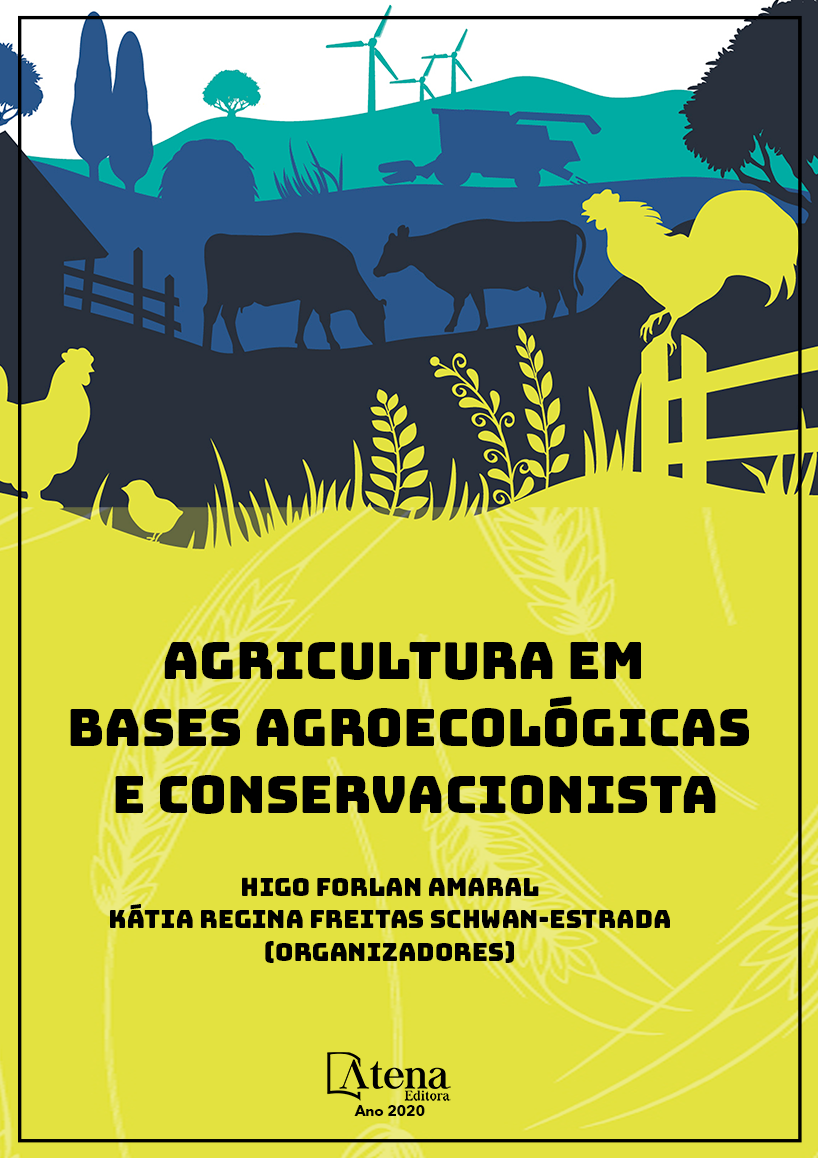
RESPOSTA DE VARIEDADE DE CULTIVO ORGÂNICO DE MILHO EM DIFERENTES FONTES DE ADUBO E INOCULAÇÃO DE Azospirillum brasilense
O uso de bactérias promotoras
de crescimento vegetal pode tornar-se de
primordial função para produção de milho em
bases orgânica e agroecológica. O objetivo do
trabalho foi avaliar a resposta de variedade
de cultivo orgânico de milho em três fontes
de adubos nitrogenados e inoculação com
Azospirillum brasilense. Instalou-se um ensaio
em delineamento inteiramente casualizado (em
casa de vegetação) em esquema fatorial 3 x
5 com quatro repetições, sendo fator 1: fonte
mineral (MIN), orgânica (ORG) e organomineral
(ORGM) de N e fator 2: 100% de adubo N, 70%
de N, 70% e inoculação com A. brasilense,
somente inoculação com A. brasilense e controle
(sem adubo e sem inoculação) para suprir 360
kg de N por ha. Aferiu-se: diâmetro do colmo
(DC), altura de planta (ALP), massa fresca da
parte aérea e radicular (MFPA e MFPR), massa
seca da parte aérea e radicular (MSPA e MSPR),
comprimento de raiz (CR), índice da área foliar
(IAF) e nitrogênio da parte aérea (N-aérea).
Realizou-se ANOVA, teste Scott-Knott em 5%
e, também, Análise de Componentes Principais
(ACP). Houve efeito significativo da interação
dos fatores para todas as variáveis. De maneira
geral, houve maior média de DC e IAF para as
adubações ORG e ORGM. Para DC houve maior
média na interação ORGM com 70%N+INO,
seguida de 100% da dose; já na adubação com
ORG obteve maior média em 100% seguida do
70%N+INO, para IAF não houve diferença para
100%N e 70%N+INO. O N-aéreo foi em média
maior nas fontes ORG e ORGM; na adubação
ORG houve maior N-aéreo em 100%N em
relação a 70%N+INO; já para adubação ORGM
houve maior N-aéreo em 70%N+INO em relação
a 100%N. A variedade de cultivo orgânico
de milho foi responsiva a recomendação de
redução de 30% de nitrogênio e inoculação
de A. brasilense, principalmente nas fontes
orgânica e organomineral.
RESPOSTA DE VARIEDADE DE CULTIVO ORGÂNICO DE MILHO EM DIFERENTES FONTES DE ADUBO E INOCULAÇÃO DE Azospirillum brasilense
-
DOI: 10.22533/at.ed.07220210219
-
Palavras-chave: promoção de crescimento vegetal, bactérias diazotróficas, agricultura orgânica, agroecologia.
-
Keywords: promotion of plant growth, diazotrophic bacteria, organic agriculture, agroecology.
-
Abstract:
Plant growth bacteria are important resources for the agroecological
production of maize, since they can substitute a significant proportion of the fertilization,
mainly nitrogen. The objective of this study was to evaluate the response of maize to
three sources of fertilizers and nitrogen and inoculation with Azospirillum brasilense
combinations. The experimental design was completely randomized (in controlled
conditions) in a 3 x 5 factorial scheme with four replicates, with factor 1: mineral source
(MIN), organic (ORG) and organomineral (ORGM) of N and factor 2: 100%, 70% of
N, 70% and inoculation with A. brasilense, only inoculation with A. brasilense and
control (without fertilizer and without inoculation) to supply 360 kg of N per hectare.
The following variables were measured: stem diameter (DC), plant height (AP), fresh
weight of leaf and root (FWL and FWR), dry weight of leaf and root (DWL and DWR),
root length CR), leaf area index (LAI) and leaf nitrogen (N-aerial). The ANOVA was
performed, Scott-Knott test at 5% and also Principal Component Analysis (PCA). There
was a higher average of DC and IAF for ORG and ORGM fertilizations. For the higher
average DC was ORGM interaction with INO + 70% N, then 100% of the dose; in the
fertilization with ORG obtained a higher average in 100% followed by 70% N + INO,
for IAF there was no difference for 100% N and 70% N + INO. N of leaf was higher in
ORG and ORGM sources of fertilizers; mainly in ORG fertilization; already for ORGM
fertilization there was higher N-aerial in 70% N + INO in relation to 100% N. The variety
of organic corn cultivation was responsive to the recommendation of 30% reduction
of nitrogen and inoculation of A. brasilense, mainly in the organic and organomineral
sources.
-
Número de páginas: 15
- Verônica de Jesus Custodio Peretto
- Higo Forlan Amaral
- Bruno


